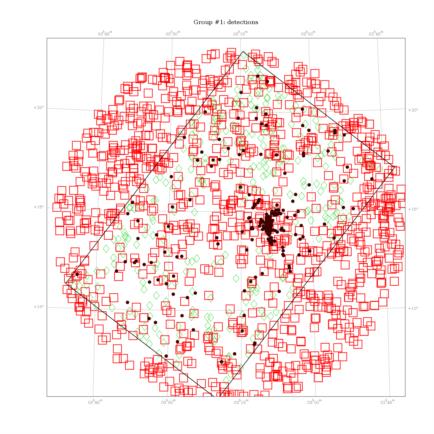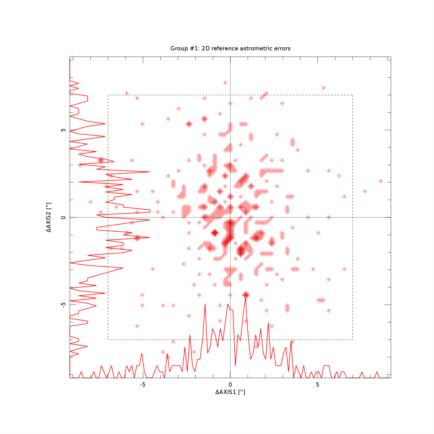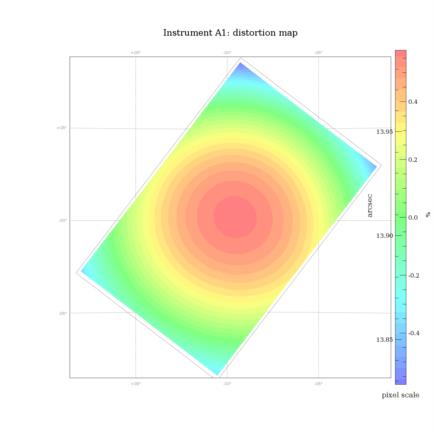
NavList:
A Community Devoted to the Preservation and Practice of Celestial Navigation and Other Methods of Traditional Wayfinding
Lunar astrometry with cameras (work in progress)
From: Peter Monta
Date: 2015 Jan 30, 17:49 -0500
- take an image with a 1000x neutral-density filter a meter or two in front of the lens, so that the Moon is well within the umbra but with plenty of unfiltered sky for stars
- register the image onto the sky using the stars as references
- estimate the Moon's position in pixels
- transform this position to (ra,dec) using the image's registration ("world coordinate system")
- done.
The astrometry tool, SCAMP, is reporting star-position errors of less than 2 arcseconds RMS against the USNO-B star catalog, so things are looking good. The global fitting might well be good to 1 arcsec or better because of the averaging effect of many reference stars. I think the lunar position can be extracted with comparable accuracy, but the potential for bias is greater because of the asymmetry.
At the risk of being long-winded, I'll give some quick commentary on the images. The first is the actual image, taken a few days ago with my trusty Canon 40D and an 85mm f/1.8 lens. Contrast is expanded to show the stars and diffuse light sources. (The Moon is actually still within the linear range of the sensor; it just looks saturated on this screenshot.) Exposure time was 1 second, and the camera was on a fixed tripod with no tracking, so the stars and Moon are both trailed to 15 arcseconds or about one pixel.
The bright blobs below center are scattered light from the stick and tape used to hold the filter. The wide "donut" of light surrounding the Moon, though, I think is atmospheric scattering. The filter attenuates it close to the Moon's position, resulting in the donut's penumbra-"hole"; and finally everything goes black in the umbra, except for the bright Moon powering its way through the filter.
The next three images are the output from SCAMP. The first shows star detections: green lozenges are matches, that is, stars present in both the image and USNO-B; black dots are false image detections due to noise; and red squares are catalog stars not present in the image (catalog was searched to mag 11, limiting magnitude of the image is about 10). The second graphic shows a scatterplot of astrometric errors; this is the main result showing the quality of the positioning. The third shows a distortion map of the lens derived from star positions alone. Pixel scale is nominally 14 arcsec/pixel for this camera and lens, but varies from center to corners due to a small amount of barrel distortion. (Note that this plot shows distortion, not vignetting.) I have about a dozen of these images, and the distortion is almost exactly the same for each, so the distortion is quite reliably estimated (I think this came up on NavList recently).
Well, the next thing is to automate the extraction of lunar position from the image so the whole thing can be wrapped up as a turnkey solution.
Cheers,
Peter
From: Peter Monta
Date: 2015 Jan 30, 17:49 -0500
Here are some astrometric results for an image of the Moon taken with a DSLR and a neutral-density filter. As has been discussed before on NavList, knowing the Moon's position on the sky gives you both your latitude and your longitude (provided an earth-rotation angle is known). One arcsecond at lunar distance is almost exactly one nautical mile (an amusing coincidence---the Moon is about 60 Earth radii out, so angles scale by that factor), so if we can estimate the Moon's position that well, we're navigating to 1 nmi accuracy.
Quick summary:- take an image with a 1000x neutral-density filter a meter or two in front of the lens, so that the Moon is well within the umbra but with plenty of unfiltered sky for stars
The next three images are the output from SCAMP. The first shows star detections: green lozenges are matches, that is, stars present in both the image and USNO-B; black dots are false image detections due to noise; and red squares are catalog stars not present in the image (catalog was searched to mag 11, limiting magnitude of the image is about 10). The second graphic shows a scatterplot of astrometric errors; this is the main result showing the quality of the positioning. The third shows a distortion map of the lens derived from star positions alone. Pixel scale is nominally 14 arcsec/pixel for this camera and lens, but varies from center to corners due to a small amount of barrel distortion. (Note that this plot shows distortion, not vignetting.) I have about a dozen of these images, and the distortion is almost exactly the same for each, so the distortion is quite reliably estimated (I think this came up on NavList recently).
Cheers,
Peter










